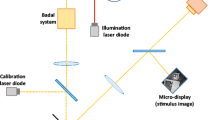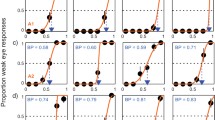Abstract
Three experiments were conducted to investigate suprathreshold contrast perception of a group of strabismic and anisometropic amblyopes. In the first experiment, simple reaction-time was measured as a function of the contrast of sinusoidal gratings. At all contrast levels, the amblyopic eyes showed prolonged reaction-times compared to the non-amblyopic eyes. In the second experiment, the perceived contrast of suprathreshold sinusoidal gratings was measured using an interocular successive matching paradigm. The third experiment compared perceived contrast of the amblyopic and non-amblyopic eye by contrast magnitude estimation. The results of the matching and magnitude estimation experiments showed that while amblyopic observers show large losses of contrast sensitivity at threshold, at suprathreshold contrast levels perceived contrast is essentially normal or near normal in the amblyopic eye. Taken together, these experiments suggest that: 1) the amblyopic eye has a higher contrast gain than the non-amblyopic eye, and 2) the amblyopic eye shows prolonged response latencies. Similar results can be obtained in normal observers under conditions of peripheral viewing and noise masking.
Similar content being viewed by others
References
Arden GB, Barnard WM and Mushin AS (1974) Visually evoked responses in amblyopia. Brit J Ophthal 58:183–192
Baker FH, Grigg P and von Noorden GK (1974) Effects of visual deprivation and strabismus on the response of neurons in the visual cortex of the monkey, including studies on the striate and prestriate cortex in the normal animal. Brain Res 66:185–208
Banks WP (1973) Reaction time as a measure of summation of warmth. Perception and Psychophysics 13:321–327
Bedell HE and Flom MC (1981) Monocular spatial distortion in amblyopia. Invest Ophthal Vis Sci 20:263–268
Blakemore C and Van Sluyters RL (1974) Reversal of the physiological effects of monocular deprivation in kittens: further evidence for a sensitivity period. J Physiol 237:195–216
Bradley A and Freeman RD (1981) Contrast sensitivity in anisometropic amblyopia. Invest Ophthal Visual Sci 21:487–476
Crawford MLJ (1978) Visual deprivation syndrome. Ophthal 85:465–477
Eggers H and Blakemore C (1978) Physiological basis of anisometropic amblyopia. Sci 201:264–267
Georgeson M and Sullivan GD (1975) Contrast constancy: deblurring in human vision by spatial frequency channels. J Physiol 252:627–656
Gottesman J, Rubin GS and Legge GE (1981) A power law for perceived contrast humans. Vision Res 21:791–800
Gstalder RJ and Green DG (1971) Laser interferometric acuity in amblyopia. J Pedia Ophthal 8:251–256
Hamasaki DI (1980) Longer latency responses of ganglion cells in cats raised with altered eye alignment. Invest Ophthal Vis Sci 19(Suppl):271
Hamasaki DI and Flynn JT (1981) Amblyopic eyes have longer reaction times. Invest Ophthal Vis Sci 21:846–853
Harwerth RS and Levi DM (1978) Reaction time as a measure of suprathreshold grating detection. Vision Res 18:1579–1586
Hess RF and Howell ER (1977) The threshold contrast sensitivity function in strabismic amblyopia: Evidence for a two-type classification. Vision Res 17:1049–1056
Hess RF and Bradley A (1980) Contrast perception above threshold is only minimally impaired in human amblyopia. Nature 287:463–464
Hess RF, Lawden MC and Campbell FW (1981) Amblyopes exhibit a phase discrimination abnormality. Invest Ophthal Vis Sci 20(Suppl):126
Higgins KE, Daughman JG and Mansfield RGW (1982) Amblyopic contrast sensitivity: insensitivity to unsteady fixation. Invest Ophthal Vis Sci 23:113–120
Hilz R, Rentschler I and Brettel H (1977) Myopia and strabismic amblyopia: substantial differences in human visual development. Exp Brain Res 30:445–446
Levi DM and Harwerth RS (1977) Spatio-temporal interactions in anisometropic and strabismic amblyopia. Invest Ophthal Vis Sci 16:90–95
Levi DM and Harwerth RS (1978) Contrast evoked potentials in amblyopia. Invest Ophtal Vis Sci 17:571–575
Levi DM, Harwerth RS and Manny RE (1979) Suprathreshold spatial frequency detection and binocular interaction in strabismic and anisometropia amblyopia. Invest Ophthal Vis Sci 18:714–725
Levi DM and Klein S (1982) Hyperacuity and amblyopia. Nature 298:268–270
Loshin DS (1977) Spatio-demporal properties of the amblyopic visual system. Doctoral dissertation, The Ohio State Univ
Luce RD and Green DM (1972) A neural timing theory for response times and the psychophysics of intensity. Psych Review 79:14–56
Marks LE (1974) On scale of sensation: Prolegomena to any future psychophysics that will be able to come forth as science. Perception and Psychophysics 16:358–376
McGill WJ (1961) Loudness and reaction time: A guided tour of the listener's private world. Acta Psychologica 19:193–199
McGill WJ (1963) Stochastic latency mechanisms. In: Handbook of Mathematical Psychology, eds: RD Luce, RR Buch and E Galanter. New York, Vol 1, p 309–360
Moody DB (1970) Reaction time as an index of sensory function. In: Animal Psychophysics, ed: WC Stebbins. New York, Appleton-Century-Crofts
Pass AF and Levi DM (1982) Spatial processing of complex stimuli in the amblyopic visual system. Invest Ophthal Vis Sci 23:780–787
Regan D (1977) Rapid methods for refracting the eye and for assessing visual acuity in amblyopia, using steady-state visual evoked potentials. In: Visual Evoked Potentials in Man: New Developments, ed: JE Desmedt. Oxford, Clarendon Press. p418–426
Sjostrand J (1978) Contrast sensitivity in amblyopia. A preliminary report. J Metab Ophthal 2:135–140
Snyder A and Shapley R (1979) Deficits in the visual evoked potentials of cats as a result of visual deprivation. Exp Brain Res 37:73–86
Sokol S (1977) Visual evoked potentials to checkerboard pattern stimuli in strabismic amblyopia. In: Visual Evoked Potentials in Man: New Developments, ed: JE Desmedt Oxford, Clarendon Press, p 410–417
Spekreijse H, Khoe LH and Van der Tweel LH (1972) A case of amblyopia; electrophysiology and psychophysics of luminance and contrast. In: The Visual System, ed: GB Arden. New York, Plenum
Stebbins WC (1966) Auditory reaction time and derivation of equal loudness contours for the monkey. J Exp Analyt 9:135–142
Stevens SS and Guira M (1967) Loudness functions under inhibition. Perception and Psychophysics 2:459–465
Thalman R (1965) Cross-modality matching in the study of abnormal loudness functions. Laryngoscope 75:1708–1726
Thomas J (1978) Normal and amblyopic contrast sensitivity functions in central and peripheral retinas. Invest Ophthal Vis Sci 17:746–753
Tyler CW, Apkarian P, Levi DM and Nakayama K (1979) Rapid assessment of visual function: An electronic sweep technique for the pattern visual evoked potential. Invest Ophthal Vis Sci 18:703–713
Tytla ME and Steinbach MJ (1982) Suprathreshold vision in amblyopia. Invest Ophthal Vis Sci 22(Suppl):88
Van Sluyters RC and Levitt F (1980) Experimental strabismus in kittens. J Neurophysiol. 48:686–699
Von Noorden GK (1961) Reaction-time in normal and amblyopic eyes. Arch Ophthal 66:695–700
Wiesel TN and Hubel DH (1965) Comparison of the effects of unilateral and bilateral eye closure on cortical unit responses in kittens. J Neurophysiol 28:1029–1040
Yinon U and Auerbach E (1975) The ocular dominance of cortical neurons in cats developed with divergent and convergent squint. Vis Res 15:1251–1256
Author information
Authors and Affiliations
Additional information
Supported by Research Grant EYO1728 from the National Eye Institute, a New Opportunities Research Support Grant from the University and a Biomedical Research Support Grant (SO7RR07147 09)
Rights and permissions
About this article
Cite this article
Loshin, D.S., Levi, D.M. Suprathreshold contrast perception in functional amblyopia. Doc Ophthalmol 55, 213–236 (1983). https://doi.org/10.1007/BF00140810
Issue Date:
DOI: https://doi.org/10.1007/BF00140810




